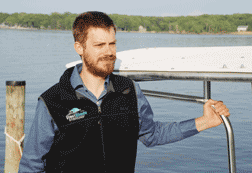Way Downstream
In Annapolis, every dog has its day. The truism’s true at least for newly instated Maryland Natural Resources Police officers Ruddy and Dock. These Doggie Do-Rights and their handlers — Cpl. John M. Vogt and officer David S. Rice — were trained by The Indiana Department of Natural Resources Division of Law Enforcement in detecting wildlife (deer and turkey), tracking and trailing humans and recovering evidence. The four-legged officers will be stationed in the Eastern and Southern Maryland regions where they join four other members of the paw police: Bear, Blu, Liberty and Patriot…

On the West and Rhode rivers, a new sheriff is in town. A new West/Rhode Riverkeeper — biologist Chris Trumbauer — will replace Bob Gallagher in patrolling the rivers, seeking better environmental law enforcement, leading restoration work and reaching out to local residents. Gallagher — who has been both riverkeeper and executive director of the program since 2005 — continues as executive director. Trumbauer — who was Maryland Department of Natural Resources’ Shallow Water Monitoring Program coordinator as well as a member of the Board of Directors of the South River Federation — steps aboard the riverkeeper boat July 7 …
In Broomes Island, sit back, relax and raise money for the Infusion Center of Calvert. The center is so small that cancer patients sometimes wait days for chemotherapy. On May 23, Stoney’s of Broomes Island teams with Everything Amish to support the center by selling handcrafted Adirondack chairs. Bid by silent auction at 6:30pm at Stoneys or purchase a chair for $1,000. Stoney’s keeps the chair on its porch, with your name or business inscribed on it. It will be waiting for you whenever you visit. Sale of the loungers has already raised $17,000 for the Infusion Center: 410-586-1888…
Around the Bay, 10 new living shoreline projects share $540,000. The half-million will help 10 area towns and groups — including Chesapeake Bay Maritime Museum, West River Center, Selby Community Association and Chesapeake Bay Field Laboratory — shore up their waterfront with natural designs, marsh grasses and other native ground stabilizers. Such soft shorelines provide habitat for wildlife and filter pollution as they prevent erosion — better than riprap, according to Robert Summers of the Maryland Department of the Environment. Each year, grants are reviewed and awarded by Chesapeake Bay Trust, with the National Oceanic and Atmospheric Administration Restoration Center, The Keith Campbell Foundation for the Environment and the National Fish and Wildlife Foundation. Since 2004, the grant program has given out more than $1.5 million for 34 projects in Maryland and Virginia, naturalizing more than 24,000 feet of shoreline…

Around the country, celebrate World Turtle Day on May 23 —a holiday sponsored by nonprofit American Tortoise Rescue to call attention to turtles and tortoises and their disappearing habitats around the world. Turtles and tortoises have been plodding around Earth for 200 million years, but the Rescue predicts the reptiles will disappear within 50 years due to the exotic food industry, habitat destruction and the pet trade. American Tortoise Rescue reminds us to never buy a turtle or tortoise (always adopt), as purchase increases demand from the wild, and to never remove a turtle from the wild unless it is injured. Find out more ways to help at www.tortoise.com…
Our Creature Feature comes from Ocean City, where blubber-laden beachcombers got Gov. Martin O’Malley’s seal of approval. The governor welcomed Arctic seals, who have chosen Ocean City for their migratory vacation spot. Department of Natural Resources biologist Tricia Kimmel believes that the seals began to appear on Maryland shorelines because the mammals have expanded their foraging territory. In the past, Grey seals, hooded seals and harp seals have been spotted in Maryland’s waters. The National Aquarium’s Jennifer Dittmar reminds you not to approach the seals as they lay on the beach — no one likes to be bothered on vacation…